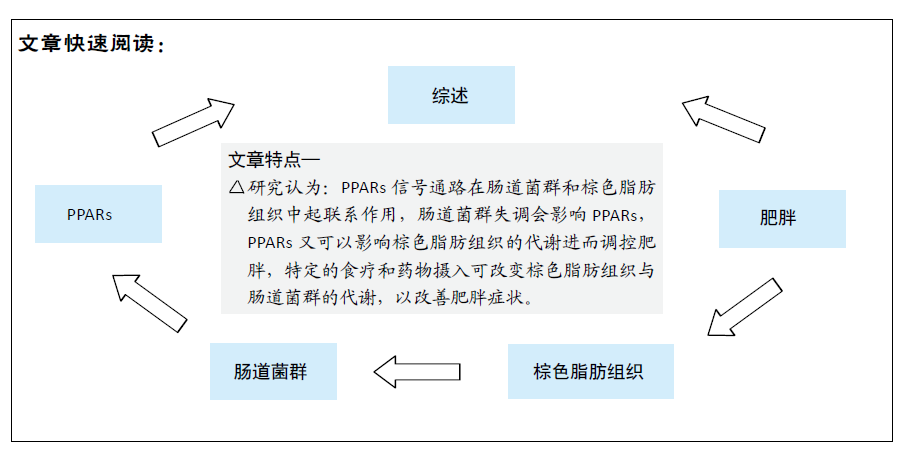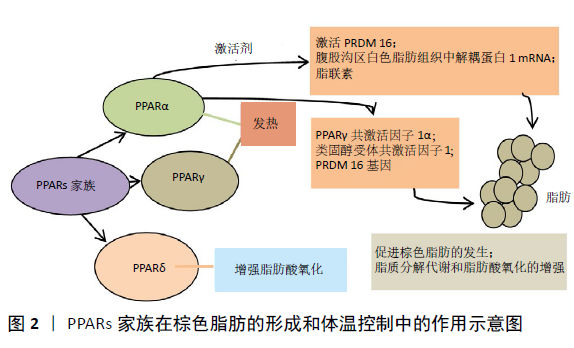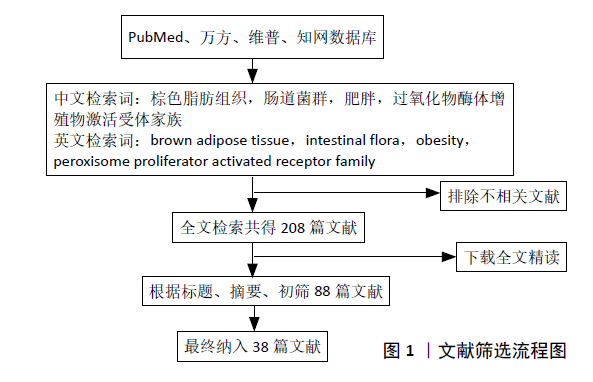[1] LIU J, WANG Y, LIN L. Small molecules for fat combustion: targeting obesity. Acta Pharmaceutica Sinica B. 2019;9(2):220-236.
[2] PRPIC V, WATSON PM, FRAMPTON IC, et al. Adaptive changes in adipocyte gene expression differ in AKR/J and SWR/J mice during diet-induced obesity. J Nutr. 2002;132(11):3325-3332.
[3] CALDERON-DOMINGUEZ M, MIR JF, FUCHO R, et al. Fatty acid metabolism and the basis of brown adipose tissue function. Adipocyte. 2016;5(2):98-118.
[4] YIN N, ZHANG H, YE R, et al. Fluvastatin Sodium Ameliorates Obesity through Brown Fat Activation. Int J Mol Sci. 2019;20(7):1622.
[5] THARP KM, STAHL A. Bioengineering Beige Adipose Tissue Therapeutics. Front Endocrinol (Lausanne). 2015;6:164.
[6] YANG JP, ANDERSON AE, MCCARTNEY A, et al. Metabolically Active Three-Dimensional Brown Adipose Tissue Engineered from White Adipose-Derived Stem Cells. Tissue Engineering Part A. 2017;23(7-8): 253-262.
[7] CORRALES P, VIDAL-PUIG A, MEDINA-GOMEZ G. PPARs and Metabolic Disorders Associated with Challenged Adipose Tissue Plasticity. Int J Mol Sci. 2018;19(7):2124.
[8] LIU J, WANG Y, LIN L. Small molecules for fat combustion: targeting obesity. Acta Pharmaceutica Sinica B. 2019;9(2):220-236.
[9] ARAKI M, NAKAGAWA Y, OISHI A, et al.The Peroxisome Proliferator-Activated Receptor alpha (PPARalpha) Agonist Pemafibrate Protects against Diet-Induced Obesity in Mice. Int J Mol Sci. 2018;19(7):2148.
[10] NAKATSU Y, MATSUNAGA Y, YAMAMOTOYA T, et al. Prolyl Isomerase Pin1 Suppresses Thermogenic Programs in Adipocytes by Promoting Degradation of Transcriptional Co-activator PRDM16. Cell Reports. 2019;26(12):3221-3230.
[11] XIONG Y, YUE F, JIA Z, et al. A novel brown adipocyte-enriched long non-coding RNA that is required for brown adipocyte differentiation and sufficient to drive thermogenic gene program in white adipocytes. Biochim Biophys Acta Mol Cell Biol Lipids. 2018;1863(4):409-419.
[12] BLANCHARD PG, MOREIRA RJ, CASTRO E, et al. PPARgamma is a major regulator of branched-chain amino acid blood levels and catabolism in white and brown adipose tissues. Metabolism. 2018;89:27-38.
[13] NAM M, AKIE TE, SANOSAKA M, et al. Mitochondrial retrograde signaling connects respiratory capacity to thermogenic gene expression. Scientific Reports. 2017;7(1):2012-2013.
[14] DUSZKA K, PICARD A, ELLERO-SIMATOS S, et al. Intestinal PPARγ signalling is required for sympathetic nervous system activation in response to caloric restriction. Scientific Reports. 2016;6(1):36937.
[15] MAKI KC, REEVES MS, FARMER M, et al. Green tea catechin consumption enhances exercise-induced abdominal fat loss in overweight and obese adults. J Nutr. 2009;139(2):264-270.
[16] WANG YX, LEE CH, TIEP S, et al. Peroxisome-proliferator-activated receptor delta activates fat metabolism to prevent obesity. Cell. 2003;113(2):159-170.
[17] EVANS RM, BARISH GD, WANG YX. PPARs and the complex journey to obesity. Nat Med. 2004;10(4):355-361.
[18] WANG C, ZENG X, ZHOU Z, et al. beta-arrestin-1 contributes to brown fat function and directly interacts with PPARalpha and PPARgamma. Sci Rep. 2016;6:26999.
[19] COUVIGNY B, DE WOUTERS T, KACI G, et al. Commensal Streptococcus salivarius Modulates PPARgamma Transcriptional Activity in Human Intestinal Epithelial Cells. PLoS One. 2015;10(5):e125371.
[20] KOH A, DE VADDER F, KOVATCHEVA-DATCHARY P, et al. From Dietary Fiber to Host Physiology: Short-Chain Fatty Acids as Key Bacterial Metabolites. Cell. 2016;165(6):1332-1345.
[21] SANNA S, VAN ZUYDAM NR, MAHAJAN A, et al. Causal relationships among the gut microbiome, short-chain fatty acids and metabolic diseases. Nat Genet. 2019;51(4):600-605.
[22] HASAN AU, RAHMAN A, KOBORI H. Interactions between Host PPARs and Gut Microbiota in Health and Disease. Int J Mol Sci. 2019;20(2):387.
[23] SHANG Y, KHAFIPOUR E, DERAKHSHANI H, et al. Short Term High Fat Diet Induces Obesity‐Enhancing Changes in Mouse Gut Microbiota That are Partially Reversed by Cessation of the High Fat Diet. Lipids. 2017;52(6):499-511.
[24] BYNDLOSS MX, OLSAN EE, RIVERA-CHÁVEZ F, et al. Microbiota-activated PPAR-γ signaling inhibits dysbiotic Enterobacteriaceae expansion. Science (New York, N.Y.). 2017;357(6351):570-575.
[25] MARION-LETELLIER R, SAVOYE G, GHOSH S. Fatty acids, eicosanoids and PPAR gamma. Eur J Pharmacol. 2016;785:44-49.
[26] LU J, BORTHWICK F, HASSANALI Z, et al.Chronic dietary n-3 PUFA intervention improves dyslipidaemia and subsequent cardiovascular complications in the JCR:LA- cp rat model of the metabolic syndrome. Br J Nutr. 2011;105(11):1572-1582.
[27] WHITE PJ, MITCHELL PL, SCHWAB M, et al. Transgenic omega-3 PUFA enrichment alters morphology and gene expression profile in adipose tissue of obese mice: Potential role for protectins. Metabolism. 2015; 64(6):666-676.
[28] 裘洁妮. 多不饱和脂肪酸对3T3-L1脂肪细胞白色脂肪棕色化的作用及机制研究[D].杭州:浙江大学,2016.
[29] HUI S, LIU Y, HUANG L, et al. Resveratrol enhances brown adipose tissue activity and white adipose tissue browning in part by regulating bile acid metabolism via gut microbiota remodeling. Int J Obes (Lond). 2020;44(8):1678-1690.
[30] MESTDAGH R, DUMAS ME, REZZI S, et al. Gut microbiota modulate the metabolism of brown adipose tissue in mice. J Proteome Res. 2012;11(2):620-630.
[31] SHENG Y, LIU J, ZHENG S, et al. Mulberry leaves ameliorate obesity through enhancing brown adipose tissue activity and modulating gut microbiota. Food Funct. 2019;10(8):4771-4781.
[32] ANHE FF, NACHBAR RT, VARIN TV, et al. Treatment with camu camu (Myrciaria dubia) prevents obesity by altering the gut microbiota and increasing energy expenditure in diet-induced obese mice. Gut. 2019;68(3):453-464.
[33] XU P, WANG J, HONG F, et al. Melatonin prevents obesity through modulation of gut microbiota in mice. J Pineal Res. 2017;62(4). doi: 10.1111/jpi.12399.
[34] YIN J, LI Y, HAN H, et al. Melatonin reprogramming of gut microbiota improves lipid dysmetabolism in high‐fat diet‐fed mice. J Pineal Res. 2018;65(4):e12524.
[35] SARMA SM, KHARE P, JAGTAP S, et al. Kodo millet whole grain and bran supplementation prevents high-fat diet induced derangements in a lipid profile, inflammatory status and gut bacteria in mice. Food Funct. 2017;8(3):1174-1183.
[36] GEURTS L, NEYRINCK AM, DELZENNE NM, et al. Gut microbiota controls adipose tissue expansion, gut barrier and glucose metabolism: novel insights into molecular targets and interventions using prebiotics. Benef Microbes. 2014;5(1):3-17.
[37] MUCCIOLI GG,NASLAIN D,BACKHED F,et al.The endocannabinoid system links gut microbiota to adipogenesis. Mol Syst Biol. 2010;6:392.
[38] XU J, XU P, HONG F, et al. DBZ is a putative PPARγ agonist that prevents high fat diet-induced obesity, insulin resistance and gut dysbiosis. Biochim Biophys Acta Gen Subj. 2017;1861(11):2690-2701.
|



